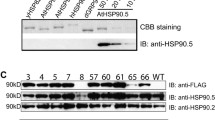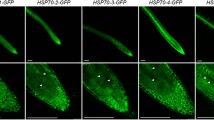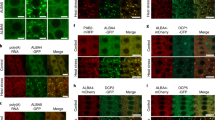Abstract
Heat shock protein 90 (Hsp90) is an abundant and highly conserved molecular chaperone. In Arabidopsis, the Hsp90 gene family consists of seven members. Here, we report that the AtHsp90-6 gene gives rise to two mRNA populations, termed AtHsp90-6L and AtHsp90-6S due to alternative initiation of transcription. The AtHsp90-6L and AtHsp90-6S transcription start sites are located 228 nucleotides upstream and 124 nucleotides downstream of the annotated translation start site, respectively. Both transcripts are detected under normal or heat-shock conditions. The inducibility of AtHsp90-6 mRNAs by heat shock implies a potential role of both isoforms in stress management. Stable transformation experiments with fusion constructs between the N-terminal part of each AtHsp90-6 isoform and green fluorescent protein indicated import of both fusion proteins into mitochondria. In planta investigation confirmed that fusion of the AtHsp90-5 N-terminus to green fluorescent protein (GFP) did result in specific chloroplastic localization. The mechanisms of regulation for mitochondria- and plastid-localized chaperone-encoding genes are not well understood. Future work is needed to address the possible roles of harsh environmental conditions and developmental processes on fine-tuning and compartmentalization of the AtHsp90-6L, AtHsp90-6S, and AtHsp90-5 proteins in Arabidopsis.







Similar content being viewed by others
References
An G, Edbert PR, Mitra A, Ha SB (1988) Binary vectors. In: Gelvin SB, Shilperoort RA, Verma DPS (eds) Plant molecular biology manual. Kluwer Academic, Dordrecht, The Netherlands
Boter M, Amigues B, Peart J, Breuer C, Kadota Y, Casais C, Moore G, Kleanthous C, Ochsenbein F, Shirasu K,Guerois R (2007) Structural and functional analysis of SGT1 reveals that its interaction with HSP90 is required for the accumulation of Rx, an R protein involved in plant immunity. Plant Cell 19:3791–3804
Cao D, Froehlich JE, Zhang H, Cheng C-L (2003) The chlorate-resistant and photomorphogenesis-defective mutant cr88 encodes a chloroplast-targeted HSP90. Plant J 33:107–118
Cechetto JD, Gupta RS (2000) Immunoelectron microscopy provides evidence that tumor necrosis factor receptor-associated protein 1 (TRAP-1) is a mitochondrial protein which also localizes at specific extramitochondrial sites. Exp Cell Res 260:30–39
Chen B, Zhong D, Monteiro A (2006) Comparative genomics and evolution of the HSP90 family of genes across all kingdoms of organisms. BMC Genomics 7:156
Clough SJ, Bent AF (1998) Floral dip: a simplified method for Agrobacterium-mediated transformation of Arabidopsis thaliana. Plant J 16:735–743
Doelling JH, Pikaard CS (1993) Transient expression in Arabidopsis thaliana protoplasts derived from rapidly established cell suspension cultures. Plant Cell Rep 12:241–244
Emelyanov V (2002) Phylogenetic relationships of organellar Hsp90 homologs reveal fundamental differences to organellar Hsp70 and Hsp60 evolution. Gene 299:125–133
Felts SJ, Owen BAL, Nguyen P, Trepel J, Donner DB, Toft DO (2000) The hsp90-related protein TRAP1 is a mitochondrial protein with distinct functional properties. J Biol Chem 275:3305–3312
Haralampidis K, Milioni D, Rigas S, Hatzopoulos P (2002) Combinatorial Interaction of cis elements specifies the expression of the Arabidopsis AtHsp90-1 gene. Plant Physiol 129:1138–1149
Heazlewood JL, Tonti-Filippini JS, Gout AM, Day DA, Whelan J, Millar AH (2004) Experimental analysis of the Arabidopsis mitochondrial proteome highlights signaling and regulatory components, provides assessment of targeting prediction programs, and indicates plant-specific mitochondrial proteins. Plant Cell 16:241–256
Iida K, Seki M, Sakurai T, Satou M, Akiyama K, Toyoda T, Konagaya A, Shinozaki K (2004) Genome-wide analysis of alternative pre-mRNA splicing in Arabidopsis thaliana based on full length cDNA sequences. Nucl Acids Res 32:5096–5103
Im CN, Lee JS, Zheng Y, Seo JS (2007) Iron chelation study in a normal human hepatocyte cell line suggests that tumor necrosis factor receptor-associated protein 1 (TRAP1) regulates production of reactive oxygen species. J Cell Biochem 100:474–486
Ishiguro S, Watanabe Y, Ito N, Nonaka H, Takeda N, Sakai T, Kanaya H, Okada K (2002) SHEPHERD is the Arabidopsis GRP94 responsible for the formation of functional CLAVATA proteins. EMBO J 21:898–908
Joab I, Radanyi C, Renoir M, Buchou T, Catelli MG, Binart N, Mester J, Baulieu EE (1984) Common non hormone binding component in non transformed chick oviduct receptors of four steroid hormones. Nature 308:850–853
Kozak M (1986) Point mutations define a sequence flanking the AUG initiator codon that modulates translation by eukaryotic ribosomes. Cell 44:283–292
Krishna P, Gloor G (2001) The Hsp90 family of proteins in Arabidopsis thaliana. Cell Stress Chaperones 6:238–246
Lund AA, Rhoads DM, Lund AL, Cerny RL, Elthon TE (2001) In vivo modifications of the maize mitochondrial small heat stress protein, HSP22. J Biol Chem 276:29924–29929
Ma L, Chen C, Liu X, Jiao Y, Su N, Li L, Wang X, Cao M, Sun N, Zhang X, Bao J, Li J, Pedersen S, Bolund L, Zhao H, Yuan L, Wong GK, Wang J, Deng XW, Wang J (2005) A microarray analysis of the rice transcriptome and its comparison to Arabidopsis. Genome Res 15:1274–1283
Masuda Y, Shima G, Aiuchi T, Horie M, Hori K, Nakajo S, Kajimoto S, Shibayama-Imazu T, Nakaya K (2004) Involvement of tumor necrosis factor receptor-associated protein 1 (TRAP1) in apoptosis induced by beta-hydroxyisovalerylshikonin. J Biol Chem 279:42503–42515
Merlin A, Voos W, Maarse AC, Meijer M, Pfanner N, Rassow J (1999) The J-related segment of Tim44 is essential for cell viability: A mutant Tim44 remains in the mitochondrial import site, but inefficiently recruits mtHsp70 and impairs protein translocation. J Cell Biol 145:961–972
Milioni D, Hatzopoulos P (1997) Genomic organization of hsp90 gene family in Arabidopsis. Plant Mol Biol 35:955–961
Millar AH, Heazlewood JL, Kristensen BK, Braun H-P, Moller IM (2005) The plant mitochondrial proteome. Trends Plant Sci 10:36–43
Obara K, Sumi K, Fukuda H (2002) The use of multiple transcription starts causes the dual targeting of Arabidopsis putative monodehydroascorbate reductase to both mitochondria and chloroplasts. Plant Cell Physiol 43:697–705
Parsley K, Hibberd JM (2006) The Arabidopsis PPDK gene is transcribed from two promoters to produce differentially expressed transcripts responsible for cytosolic and plastidic proteins. Plant Mol Biol 62:339–349
Peltier JB, Ripoll DR, Friso G, Rudella A, Cai Y, Ytterberg J, Giacomelli L, Pillardy J, Van Wijk KJ (2004) Clp protease complexes from photosynthetic and non-photosynthetic plastids and mitochondria of plants, their predicted 3-D structures and functional implications. J Biol Chem 279:4768–4781
Pearl LH, Prodromou C (2002) Structure, function and mechanism of the Hsp90 molecular chaperone. Adv Protein Chem 59:157–186
Prasinos C, Krampis K, Samakovli D, Hatzopoulos P (2004) Tight regulation of expression of two Arabidopsis cytosolic Hsp90 genes during embryo development. J Exp Bot 56:633–644
Queitsch C, Sangster TA, Lindquist S (2002) Hsp90 as a capacitor of phenotypic variation. Nature 417:618–624
Rhoads DM, White SJ, Zhou Y, Muralidharan M, Elthon TE (2005) Altered gene expression in plants with constitutive expression of a mitochondrial small heat shock protein suggests the involvement of retrograde regulation in the heat stress response. Physiol Plant 123:435–444
Rieping M, Schoffl F (1992) Synergistic effect of upstream sequences, CCAAT box elements, and HSE sequences for enhanced expression of chimeric heat-shock genes in transgenic tobacco. Mol Gen Genet 231:226–232
Rutherford SL, Lindquist S (1998) Hsp90 as a capacitor for morphological evolution. Nature 396:336–342
Salvador ML, Suay L, Anthonisen IL, Klein U (2004) Changes in the 5′-untranslated region of the rbcL gene accelerate transcript degradation more than 50-fold in the chloroplast of Chlamydomonas reinhardtii. Curr Genet 45:176–182
Samakovli D, Thanou A, Vamas C, Hatzopoulos P (2007) Hsp90 canalizes developmental perturbation. J Exp Bot 58:3513–3524
Sangster TA, Queitsch C (2005) The HSP90 chaperone complex, an emerging force in plant development and phenotypic plasticity. Curr Opin Plant Biol 8:86–92
Schaaf JM, Cidlowski JA (2002) Molecular mechanisms of glucocorticoid action and resistance. J Steroid Biochem Mol Biol 83:37–48
Schatz G, Dobberstein B (1996) Common principles of protein translocation across membranes. Science 271:1519–1526
Sepehrnia B, Paz IB, Dasgupta G, Momand J (1996) Heat shock protein 84 forms a complex with mutant p53 protein predominantly within a cytoplasmic compartment of the cell. J Biol Chem 271:15084–15090
Shimizu S, Nomura K, Ujihara M, Demura H (1999) An additional exon of stress-inducible heat shock protein 70 gene (HSP70–1). Biochem Biophys Res Commun 257:193–198
Sigler PB, Xu Z, Rye HS, Burston SG, Fenton WA, Horwich AL (1998) Links, structure and function in GroEL-mediated protein folding. Annu Rev Biochem 67:581–608
Silva-Filho MC (2003) One ticket for multiple destinations: dual targeting of proteins to distinct subcellular locations. Curr Opin Plant Biol 6:589–595
Sionov RV, Cohen O, Kfir S, Zilberman Y, Yefeno E (2006) Role of mitochondrial glucocorticoid receptor in glucocorticoid-induced apoptosis. J Exp Med 203:189–203
Song HY, Dunbar JD, Zhang Y X, Guo D, Donner DB (1995) Identification of a protein with homology to hsp90 that binds the type 1 tumor necrosis factor receptor. J Biol Chem 270:3574–3581
Stechmann A, Cavalier-Smith T (2004) Evolutionary origins of Hsp90 chaperones and a deep paralogy in their bacterial ancestors. J Eukaryot Microbiol 51:364–373
Sun W, Van Montagu M, Verbruggen N (2002) Small heat shock proteins and stress tolerance in plants. Biochim Biophys Acta 1577:1–9
Takahashi A, Casais C, Ichimura K, Shirasu K (2003) HSP90 interacts with RAR1 and SGT1 and is essential for RPS2-mediated disease resistance in Arabidopsis. Proc Natl Acad Sci USA 100:11777–11782
Taylor NL, Heazlewood JL, Day DA, Millar AH (2005) Differential impact of environmental stresses on the pea mitochondrial proteome. Mol Cell Proteomics 4:1122–1133
Wachter A, Wolf S, Steininger H, Bogs J, Rausch T (2005) Differential targeting of GSH1 and GSH2 is achieved by multiple transcription initiation: implications for the compartmentation of glutathione biosynthesis in the Brassicaceae. Plant J 41:15–30
Wang BB, Brendel V (2006) Genome wide comparative analysis of alternative splicing in plants. Proc Natl Acad Sci USA 103:7175–7180
Wegele H, Muller L, Buchner J (2004) Hsp70 and Hsp90—a relay team for protein folding. Rev Physiol Biochem Pharmacol 151:1–44
Wilhelmsson A, Cuthill S, Denis M, Wikstrom AC, Gustafsson JA, Poellinger L (1990) The specific DNA binding activity of the dioxin receptor is modulated by the 90 kd heat shock protein. EMBO J 9:69–76
Yamaguchi H, Morita T, Amagai A, Maeda Y (2005) Changes in spatial and temporal localization of Dictyostelium homologues of TRAP1 and GRP94 revealed by immunoelectron microscopy. Exp Cell Res 303:415–424
Young JC, Moarefi I, Hartl FU (2001) Hsp90: a specialized but essential protein-folding tool. J Cell Biol 154:267–273
Yu J, Nickels R, McIntosh L (2001) A genome approach to mitochondrial–nuclear communication in Arabidopsis. Plant Physiol Biochem 39: 345–353
Zhang Y, Dorey S, Swiderski M, Jones JDG (2004) Expression of RPS4 in tobacco induces an AvrRps4-independent HR that requires EDS1, SGT1 and HSP90. Plant J 40:213–224
Zhao Q, Wang J, Levichkin IV, Stasinopoulos S, Ryan MT, Hoogenraad NJ (2002) A mitochondrial specific stress response in mammalian cells. EMBO J 21:4411–4419
Zhao R, Davey M, Hsu Y-C, Kaplanek P, Tong A, Parsons AB, Krogan N, Cagney G, Mai D, Greenblatt J, Boone C, Emili A, Houry WA (2005) Navigating the chaperone network: an integrative map of physical and genetic interactions mediated by the Hsp90 chaperone. Cell 5:715–727
Acknowledgements
We would like to thank Elli Hatzistavrou for technical assistance. This work was partly supported by a grant to PH from the GSRT, Greece (PENED 01/148) and Pythagoras I.
Author information
Authors and Affiliations
Corresponding author
Rights and permissions
About this article
Cite this article
Prassinos, C., Haralampidis, K., Milioni, D. et al. Complexity of Hsp90 in organelle targeting. Plant Mol Biol 67, 323–334 (2008). https://doi.org/10.1007/s11103-008-9322-8
Received:
Accepted:
Published:
Issue Date:
DOI: https://doi.org/10.1007/s11103-008-9322-8




